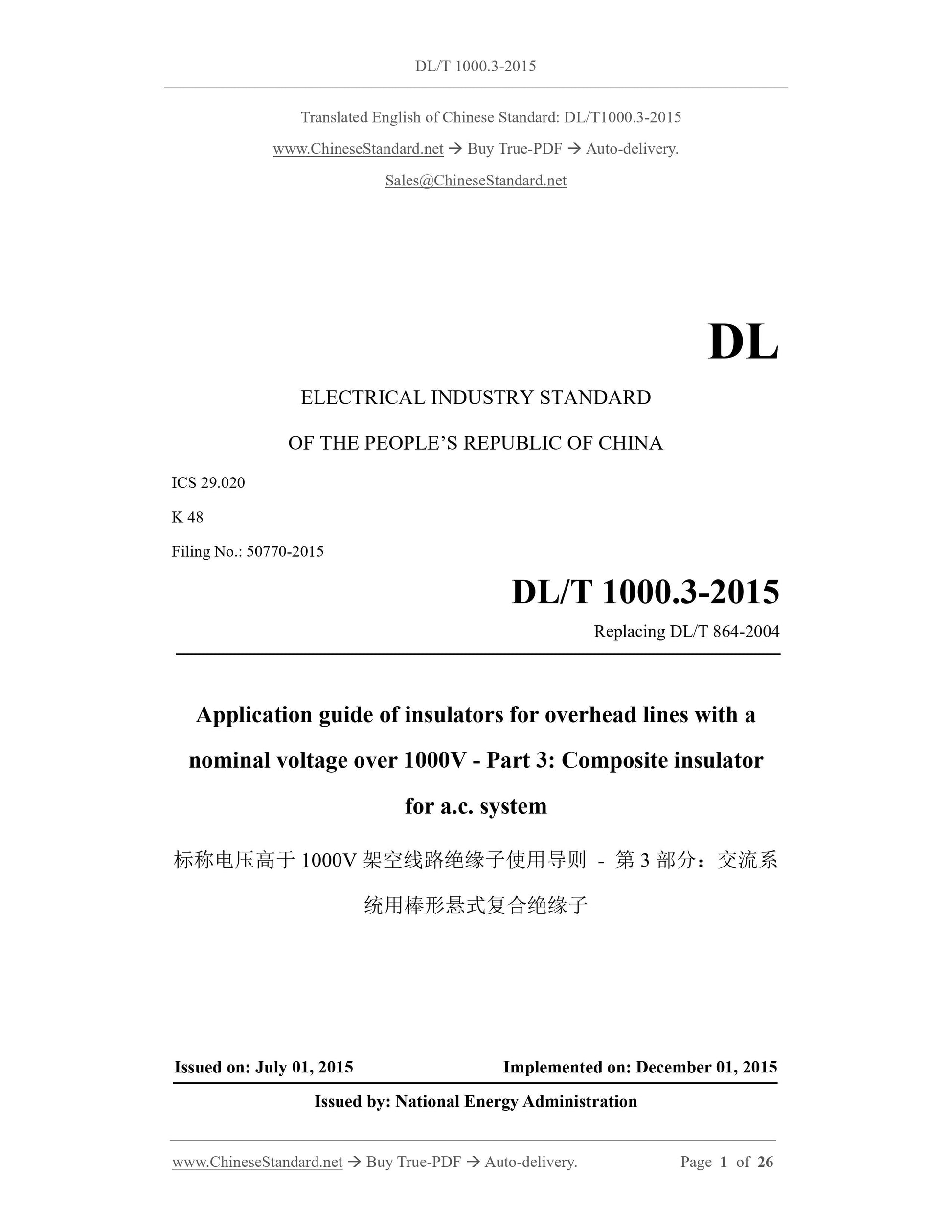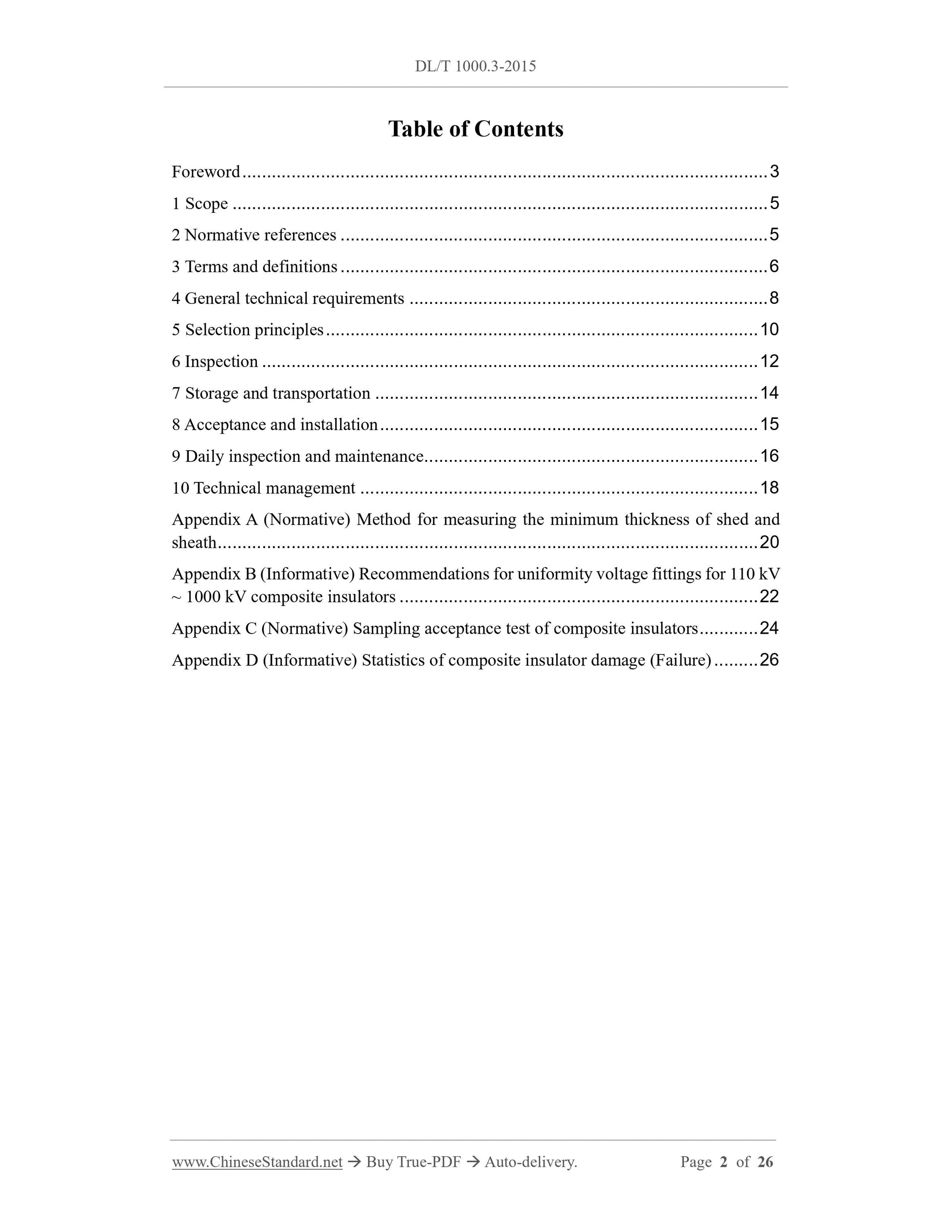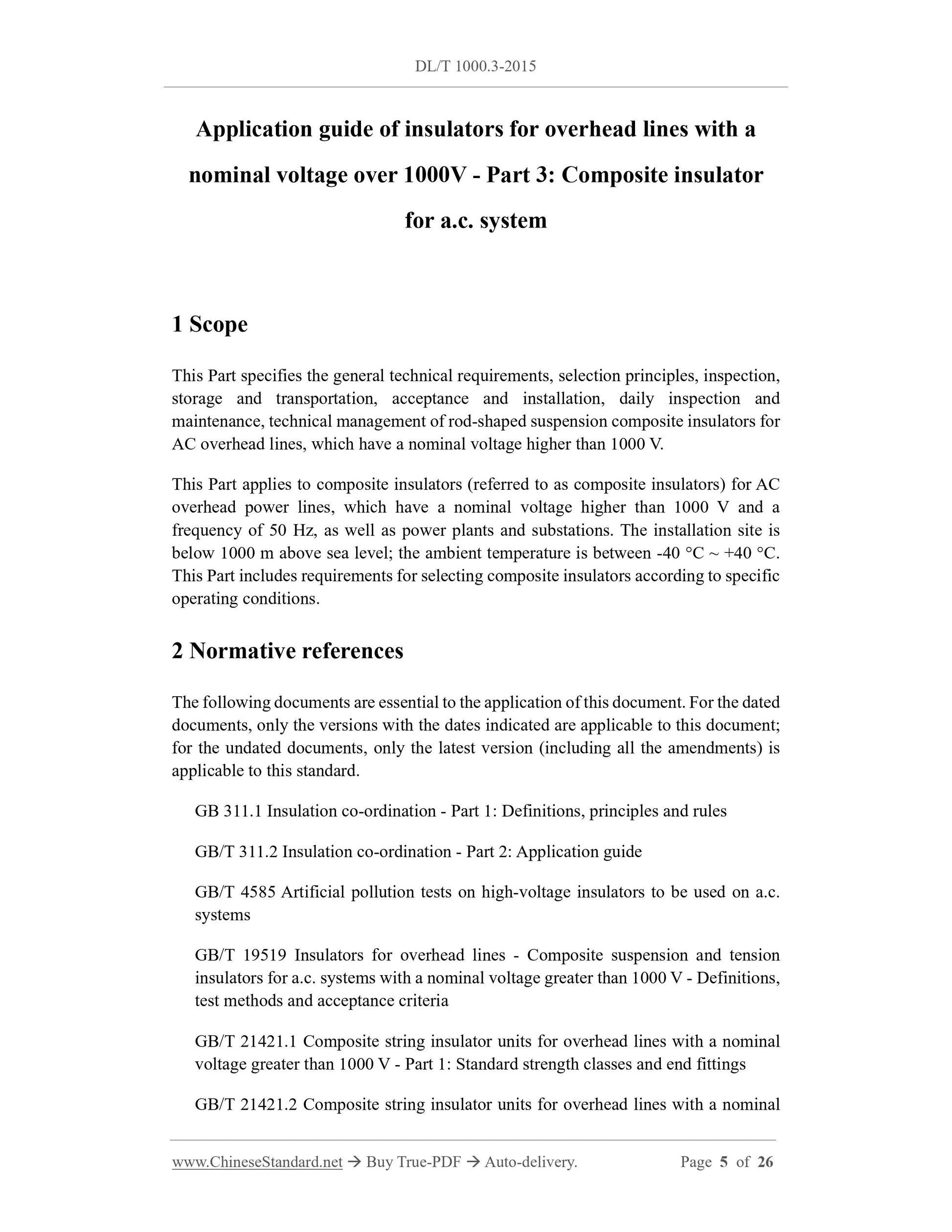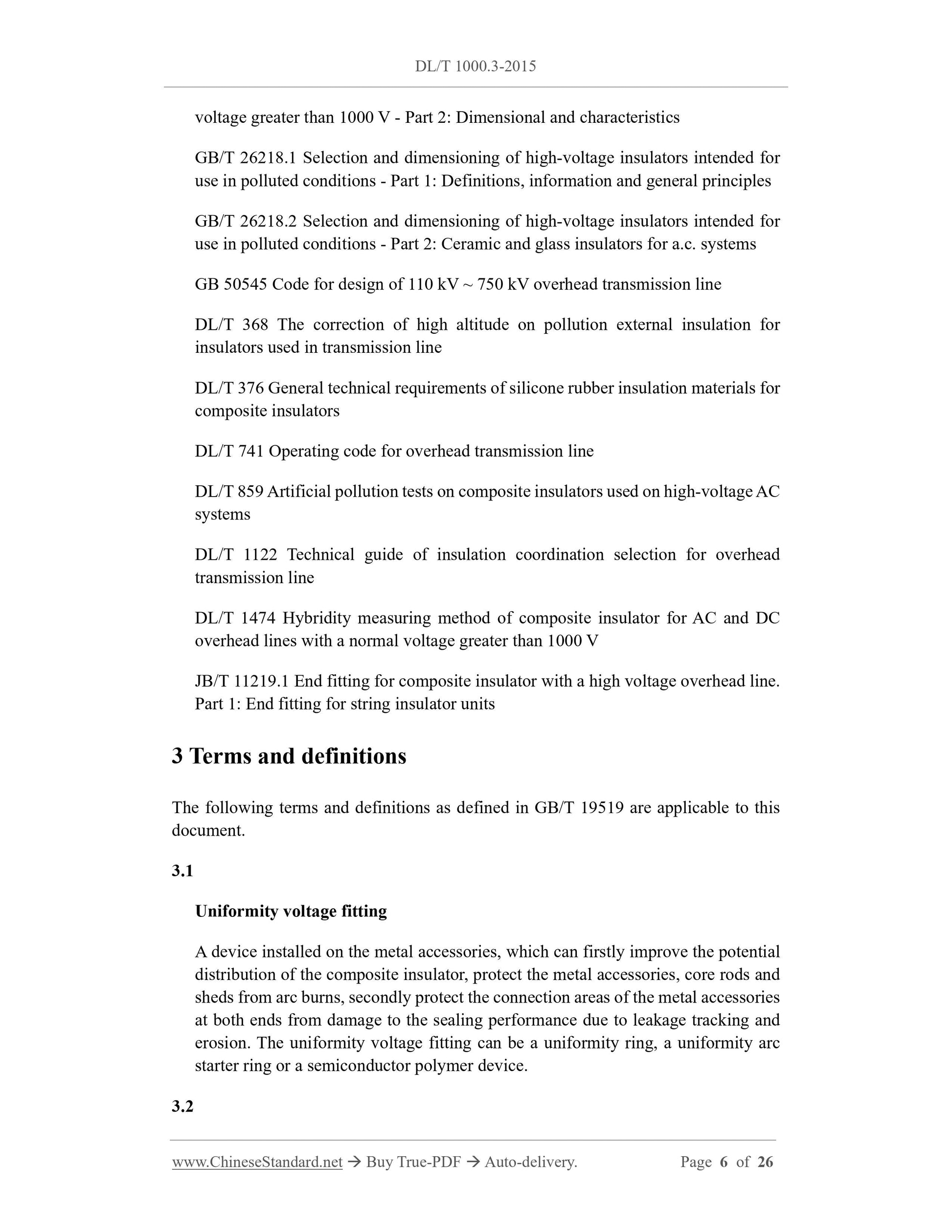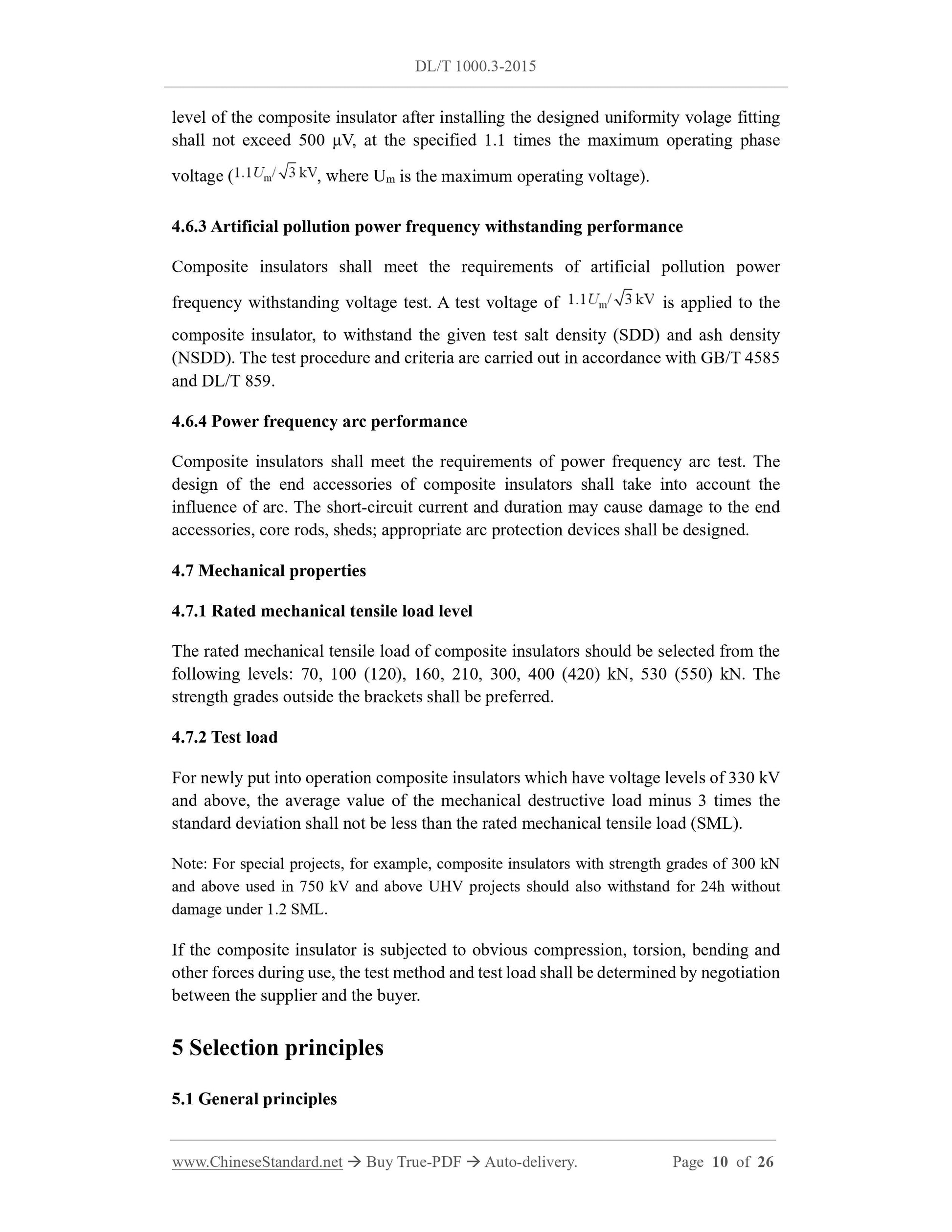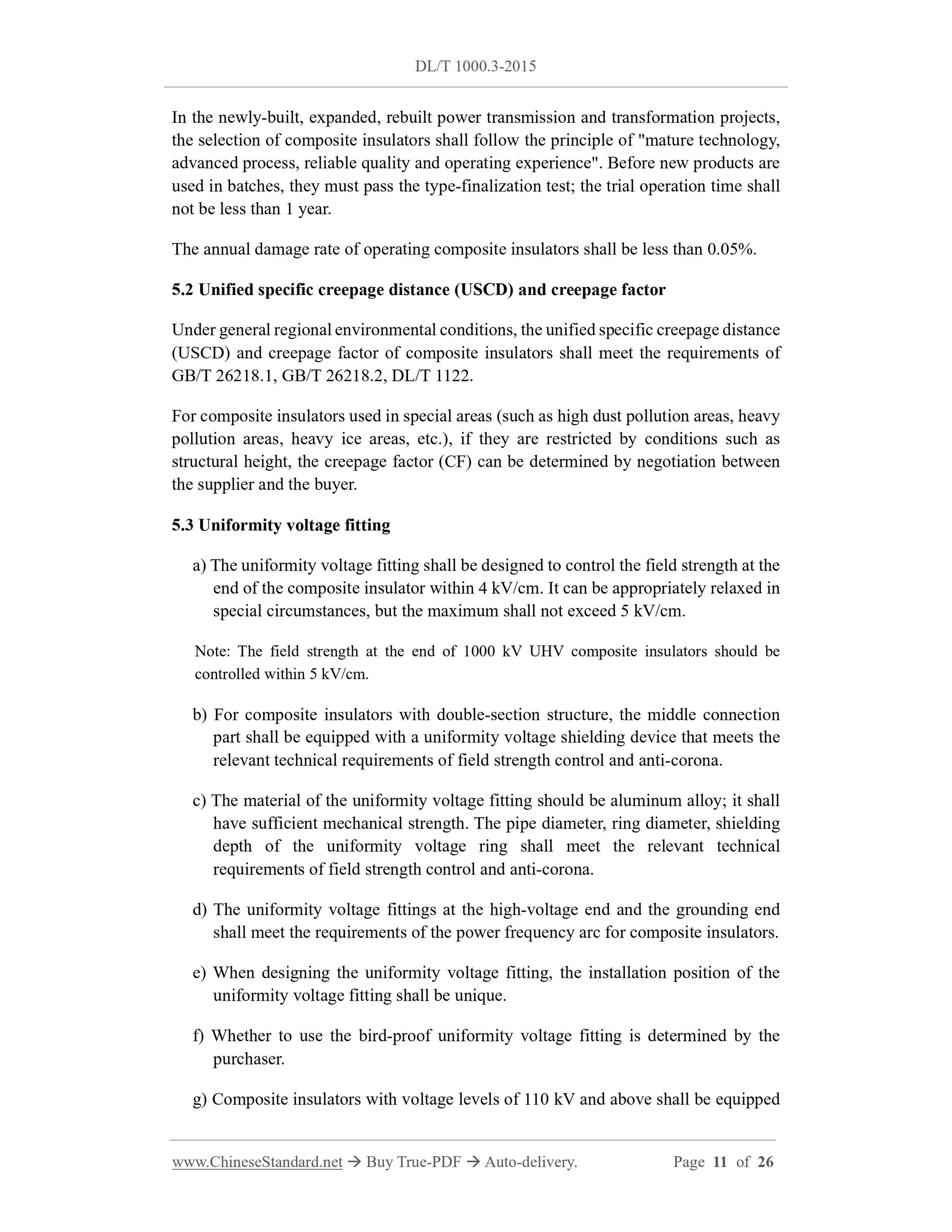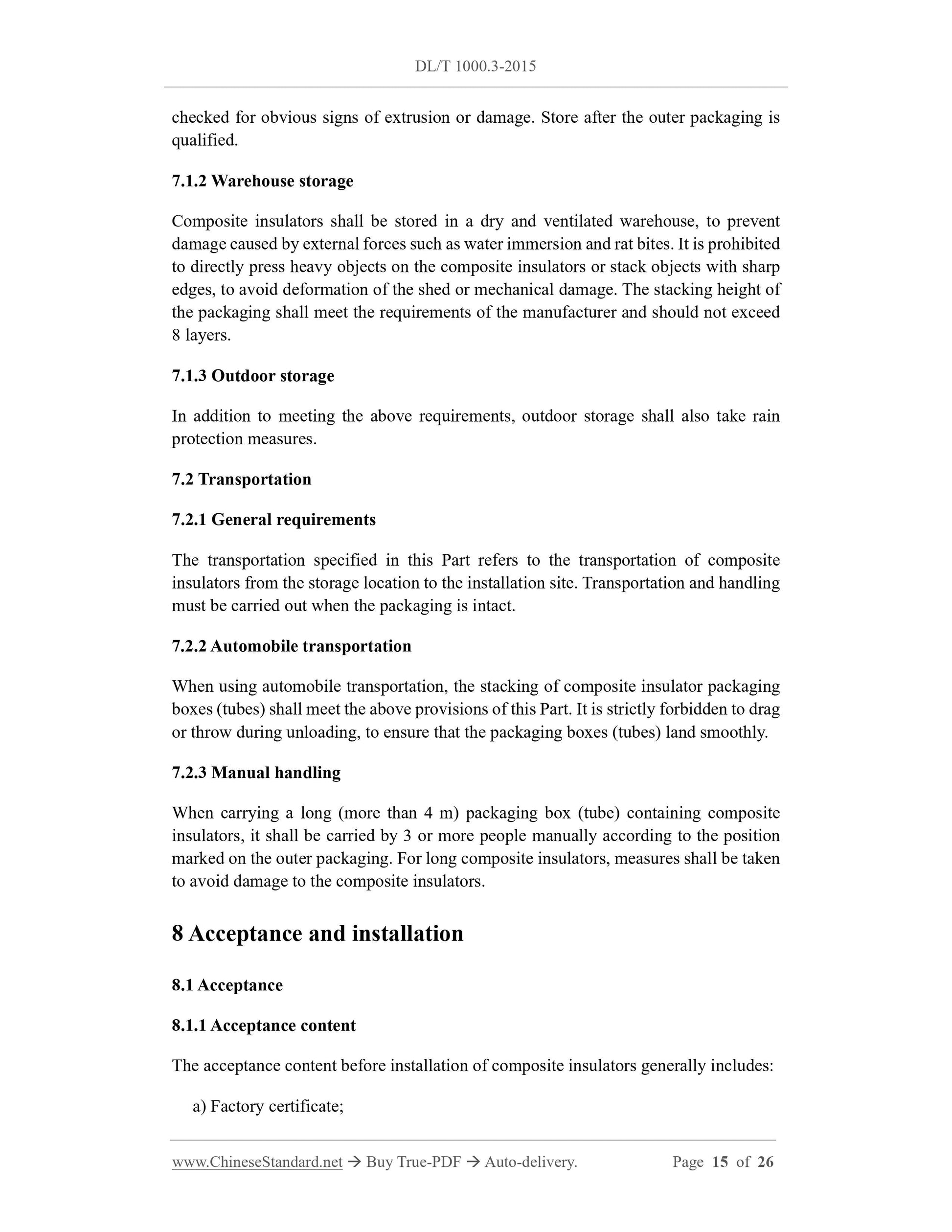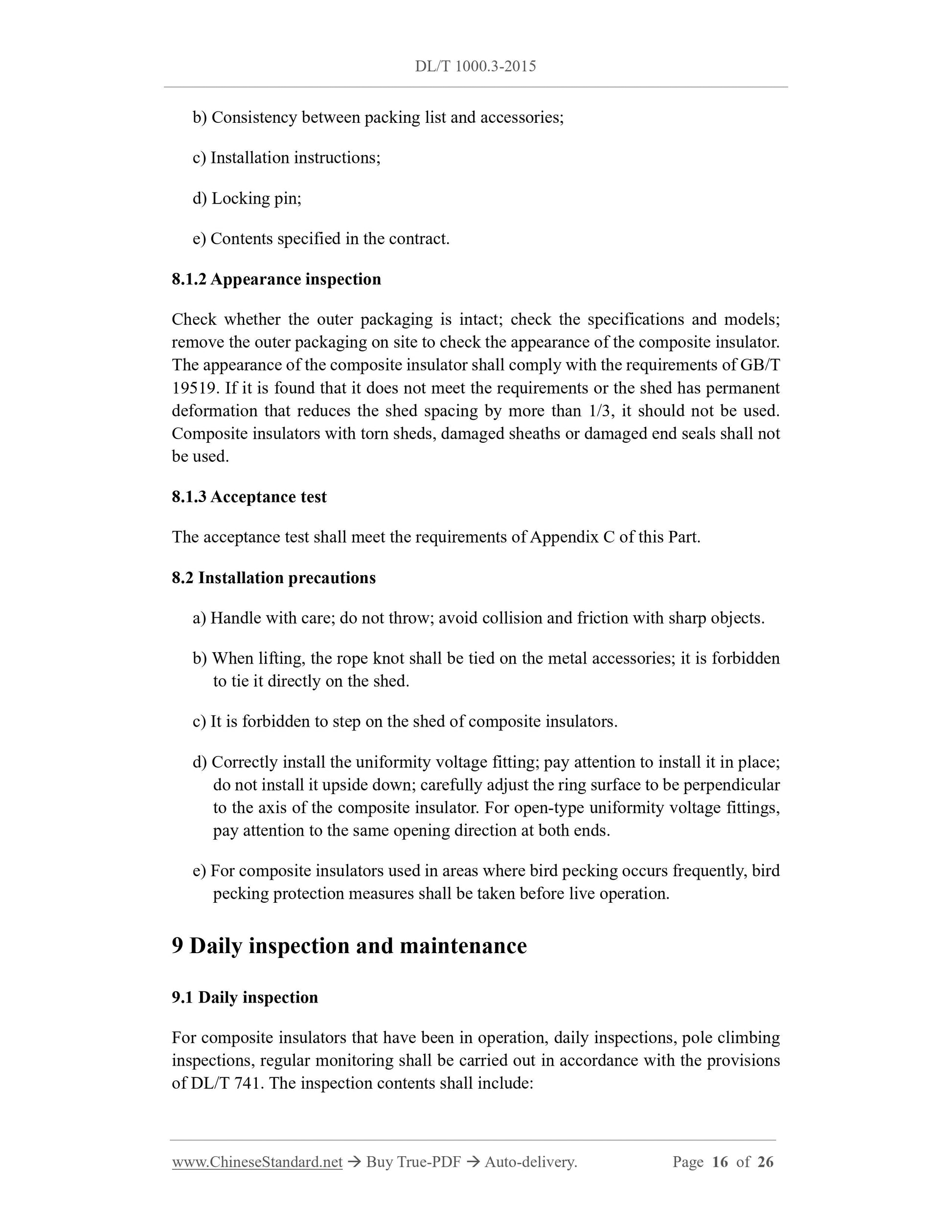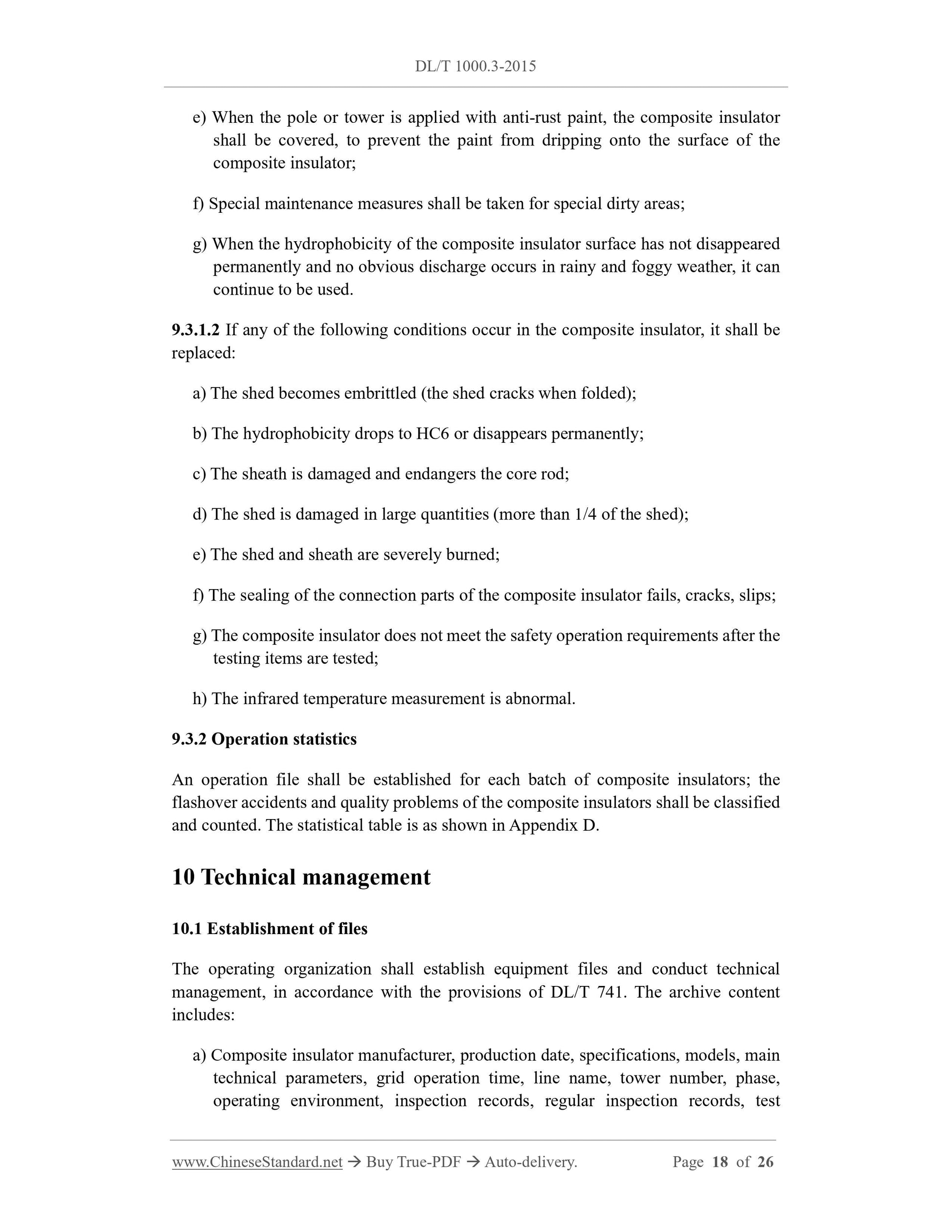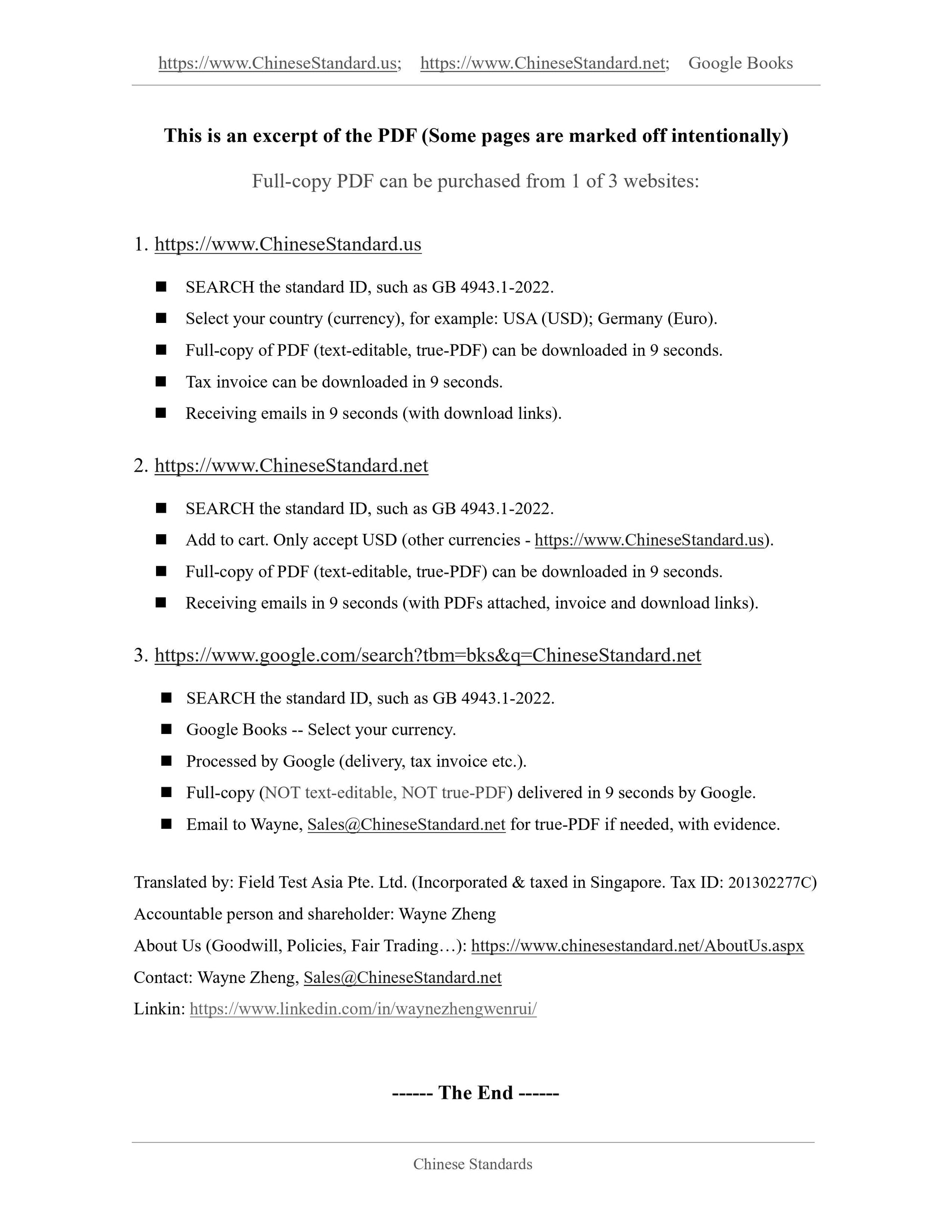1
/
su
10
PayPal, credit cards. Download editable-PDF and invoice in 1 second!
DL/T 1000.3-2015 English PDF (DLT1000.3-2015)
DL/T 1000.3-2015 English PDF (DLT1000.3-2015)
Prezzo di listino
$370.00 USD
Prezzo di listino
Prezzo scontato
$370.00 USD
Prezzo unitario
/
per
Spese di spedizione calcolate al check-out.
Impossibile caricare la disponibilità di ritiro
Delivery: 3 seconds. Download true-PDF + Invoice.
Get QUOTATION in 1-minute: Click DL/T 1000.3-2015
Historical versions: DL/T 1000.3-2015
Preview True-PDF (Reload/Scroll if blank)
DL/T 1000.3-2015: Application guide of insulators for overhand lines with a nominal voltage over 1000V Part 3: Composite insulator for a.c. system
DL/T 1000.3-2015
DL
ELECTRICAL INDUSTRY STANDARD
OF THE PEOPLE’S REPUBLIC OF CHINA
ICS 29.020
K 48
Filing No.: 50770-2015
Replacing DL/T 864-2004
Application guide of insulators for overhead lines with a
nominal voltage over 1000V - Part 3: Composite insulator
for a.c. system
ISSUED ON: JULY 01, 2015
IMPLEMENTED ON: DECEMBER 01, 2015
Issued by: National Energy Administration
Table of Contents
Foreword ... 3
1 Scope ... 5
2 Normative references ... 5
3 Terms and definitions ... 6
4 General technical requirements ... 8
5 Selection principles ... 10
6 Inspection ... 12
7 Storage and transportation ... 14
8 Acceptance and installation ... 15
9 Daily inspection and maintenance ... 16
10 Technical management ... 18
Appendix A (Normative) Method for measuring the minimum thickness of shed and
sheath ... 20
Appendix B (Informative) Recommendations for uniformity voltage fittings for 110 kV
~ 1000 kV composite insulators ... 22
Appendix C (Normative) Sampling acceptance test of composite insulators ... 24
Appendix D (Informative) Statistics of composite insulator damage (Failure) ... 26
Application guide of insulators for overhead lines with a
nominal voltage over 1000V - Part 3: Composite insulator
for a.c. system
1 Scope
This Part specifies the general technical requirements, selection principles, inspection,
storage and transportation, acceptance and installation, daily inspection and
maintenance, technical management of rod-shaped suspension composite insulators for
AC overhead lines, which have a nominal voltage higher than 1000 V.
This Part applies to composite insulators (referred to as composite insulators) for AC
overhead power lines, which have a nominal voltage higher than 1000 V and a
frequency of 50 Hz, as well as power plants and substations. The installation site is
below 1000 m above sea level; the ambient temperature is between -40 °C ~ +40 °C.
This Part includes requirements for selecting composite insulators according to specific
operating conditions.
2 Normative references
The following documents are essential to the application of this document. For the dated
documents, only the versions with the dates indicated are applicable to this document;
for the undated documents, only the latest version (including all the amendments) is
applicable to this standard.
GB 311.1 Insulation co-ordination - Part 1: Definitions, principles and rules
GB/T 311.2 Insulation co-ordination - Part 2: Application guide
GB/T 4585 Artificial pollution tests on high-voltage insulators to be used on a.c.
systems
GB/T 19519 Insulators for overhead lines - Composite suspension and tension
insulators for a.c. systems with a nominal voltage greater than 1000 V - Definitions,
test methods and acceptance criteria
GB/T 21421.1 Composite string insulator units for overhead lines with a nominal
voltage greater than 1000 V - Part 1: Standard strength classes and end fittings
GB/T 21421.2 Composite string insulator units for overhead lines with a nominal
voltage greater than 1000 V - Part 2: Dimensional and characteristics
GB/T 26218.1 Selection and dimensioning of high-voltage insulators intended for
use in polluted conditions - Part 1: Definitions, information and general principles
GB/T 26218.2 Selection and dimensioning of high-voltage insulators intended for
use in polluted conditions - Part 2: Ceramic and glass insulators for a.c. systems
GB 50545 Code for design of 110 kV ~ 750 kV overhead transmission line
DL/T 368 The correction of high altitude on pollution external insulation for
insulators used in transmission line
DL/T 376 General technical requirements of silicone rubber insulation materials for
composite insulators
DL/T 741 Operating code for overhead transmission line
DL/T 859 Artificial pollution tests on composite insulators used on high-voltage AC
systems
DL/T 1122 Technical guide of insulation coordination selection for overhead
transmission line
DL/T 1474 Hybridity measuring method of composite insulator for AC and DC
overhead lines with a normal voltage greater than 1000 V
JB/T 11219.1 End fitting for composite insulator with a high voltage overhead line.
Part 1: End fitting for string insulator units
3 Terms and definitions
The following terms and definitions as defined in GB/T 19519 are applicable to this
document.
3.1
Uniformity voltage fitting
A device installed on the metal accessories, which can firstly improve the potential
distribution of the composite insulator, protect the metal accessories, core rods and
sheds from arc burns, secondly protect the connection areas of the metal accessories
at both ends from damage to the sealing performance due to leakage tracking and
erosion. The uniformity voltage fitting can be a uniformity ring, a uniformity arc
starter ring or a semiconductor polymer device.
3.2
level of the composite insulator after installing the designed uniformity volage fitting
shall not exceed 500 μV, at the specified 1.1 times the maximum operating phase
voltage ( , where Um is the maximum operating voltage).
4.6.3 Artificial pollution power frequency withstanding performance
Composite insulators shall meet the requirements of artificial pollution power
frequency withstanding voltage test. A test voltage of is applied to the
composite insulator, to withstand the given test salt density (SDD) and ash density
(NSDD). The test procedure and criteria are carried out in accordance with GB/T 4585
and DL/T 859.
4.6.4 Power frequency arc performance
Composite insulators shall meet the requirements of power frequency arc test. The
design of the end accessories of composite insulators shall take into account the
influence of arc. The short-circuit current and duration may cause damage to the end
accessories, core rods, sheds; appropriate arc protection devices shall be designed.
4.7 Mechanical properties
4.7.1 Rated mechanical tensile load level
The rated mechanical tensile load of composite insulators should be selected from the
following levels: 70, 100 (120), 160, 210, 300, 400 (420) kN, 530 (550) kN. The
strength grades outside the brackets shall be preferred.
4.7.2 Test load
For newly put into operation composite insulators which have voltage levels of 330 kV
and above, the average value of the mechanical destructive load minus 3 times the
standard deviation shall not be less than the rated mechanical tensile load (SML).
Note: For special projects, for example, composite insulators with strength grades of 300 kN
and above used in 750 kV and above UHV projects should also withstand for 24h without
damage under 1.2 SML.
If the composite insulator is subjected to obvious compression, torsion, bending and
other forces during use, the test method and test load shall be determined by negotiation
between the supplier and the buyer.
5 Selection principles
5.1 General principles
In the newly-built, expanded, rebuilt power transmission and transformation projects,
the selection of composite insulators shall follow the principle of "mature technology,
advanced process, reliable quality and operating experience". Before new products are
used in batches, they must pass the type-finalization test; the trial operation time shall
not be less than 1 year.
The annual damage rate of operating composite insulators shall be less than 0.05%.
5.2 Unified specific creepage distance (USCD) and creepage factor
Under general r...
Get QUOTATION in 1-minute: Click DL/T 1000.3-2015
Historical versions: DL/T 1000.3-2015
Preview True-PDF (Reload/Scroll if blank)
DL/T 1000.3-2015: Application guide of insulators for overhand lines with a nominal voltage over 1000V Part 3: Composite insulator for a.c. system
DL/T 1000.3-2015
DL
ELECTRICAL INDUSTRY STANDARD
OF THE PEOPLE’S REPUBLIC OF CHINA
ICS 29.020
K 48
Filing No.: 50770-2015
Replacing DL/T 864-2004
Application guide of insulators for overhead lines with a
nominal voltage over 1000V - Part 3: Composite insulator
for a.c. system
ISSUED ON: JULY 01, 2015
IMPLEMENTED ON: DECEMBER 01, 2015
Issued by: National Energy Administration
Table of Contents
Foreword ... 3
1 Scope ... 5
2 Normative references ... 5
3 Terms and definitions ... 6
4 General technical requirements ... 8
5 Selection principles ... 10
6 Inspection ... 12
7 Storage and transportation ... 14
8 Acceptance and installation ... 15
9 Daily inspection and maintenance ... 16
10 Technical management ... 18
Appendix A (Normative) Method for measuring the minimum thickness of shed and
sheath ... 20
Appendix B (Informative) Recommendations for uniformity voltage fittings for 110 kV
~ 1000 kV composite insulators ... 22
Appendix C (Normative) Sampling acceptance test of composite insulators ... 24
Appendix D (Informative) Statistics of composite insulator damage (Failure) ... 26
Application guide of insulators for overhead lines with a
nominal voltage over 1000V - Part 3: Composite insulator
for a.c. system
1 Scope
This Part specifies the general technical requirements, selection principles, inspection,
storage and transportation, acceptance and installation, daily inspection and
maintenance, technical management of rod-shaped suspension composite insulators for
AC overhead lines, which have a nominal voltage higher than 1000 V.
This Part applies to composite insulators (referred to as composite insulators) for AC
overhead power lines, which have a nominal voltage higher than 1000 V and a
frequency of 50 Hz, as well as power plants and substations. The installation site is
below 1000 m above sea level; the ambient temperature is between -40 °C ~ +40 °C.
This Part includes requirements for selecting composite insulators according to specific
operating conditions.
2 Normative references
The following documents are essential to the application of this document. For the dated
documents, only the versions with the dates indicated are applicable to this document;
for the undated documents, only the latest version (including all the amendments) is
applicable to this standard.
GB 311.1 Insulation co-ordination - Part 1: Definitions, principles and rules
GB/T 311.2 Insulation co-ordination - Part 2: Application guide
GB/T 4585 Artificial pollution tests on high-voltage insulators to be used on a.c.
systems
GB/T 19519 Insulators for overhead lines - Composite suspension and tension
insulators for a.c. systems with a nominal voltage greater than 1000 V - Definitions,
test methods and acceptance criteria
GB/T 21421.1 Composite string insulator units for overhead lines with a nominal
voltage greater than 1000 V - Part 1: Standard strength classes and end fittings
GB/T 21421.2 Composite string insulator units for overhead lines with a nominal
voltage greater than 1000 V - Part 2: Dimensional and characteristics
GB/T 26218.1 Selection and dimensioning of high-voltage insulators intended for
use in polluted conditions - Part 1: Definitions, information and general principles
GB/T 26218.2 Selection and dimensioning of high-voltage insulators intended for
use in polluted conditions - Part 2: Ceramic and glass insulators for a.c. systems
GB 50545 Code for design of 110 kV ~ 750 kV overhead transmission line
DL/T 368 The correction of high altitude on pollution external insulation for
insulators used in transmission line
DL/T 376 General technical requirements of silicone rubber insulation materials for
composite insulators
DL/T 741 Operating code for overhead transmission line
DL/T 859 Artificial pollution tests on composite insulators used on high-voltage AC
systems
DL/T 1122 Technical guide of insulation coordination selection for overhead
transmission line
DL/T 1474 Hybridity measuring method of composite insulator for AC and DC
overhead lines with a normal voltage greater than 1000 V
JB/T 11219.1 End fitting for composite insulator with a high voltage overhead line.
Part 1: End fitting for string insulator units
3 Terms and definitions
The following terms and definitions as defined in GB/T 19519 are applicable to this
document.
3.1
Uniformity voltage fitting
A device installed on the metal accessories, which can firstly improve the potential
distribution of the composite insulator, protect the metal accessories, core rods and
sheds from arc burns, secondly protect the connection areas of the metal accessories
at both ends from damage to the sealing performance due to leakage tracking and
erosion. The uniformity voltage fitting can be a uniformity ring, a uniformity arc
starter ring or a semiconductor polymer device.
3.2
level of the composite insulator after installing the designed uniformity volage fitting
shall not exceed 500 μV, at the specified 1.1 times the maximum operating phase
voltage ( , where Um is the maximum operating voltage).
4.6.3 Artificial pollution power frequency withstanding performance
Composite insulators shall meet the requirements of artificial pollution power
frequency withstanding voltage test. A test voltage of is applied to the
composite insulator, to withstand the given test salt density (SDD) and ash density
(NSDD). The test procedure and criteria are carried out in accordance with GB/T 4585
and DL/T 859.
4.6.4 Power frequency arc performance
Composite insulators shall meet the requirements of power frequency arc test. The
design of the end accessories of composite insulators shall take into account the
influence of arc. The short-circuit current and duration may cause damage to the end
accessories, core rods, sheds; appropriate arc protection devices shall be designed.
4.7 Mechanical properties
4.7.1 Rated mechanical tensile load level
The rated mechanical tensile load of composite insulators should be selected from the
following levels: 70, 100 (120), 160, 210, 300, 400 (420) kN, 530 (550) kN. The
strength grades outside the brackets shall be preferred.
4.7.2 Test load
For newly put into operation composite insulators which have voltage levels of 330 kV
and above, the average value of the mechanical destructive load minus 3 times the
standard deviation shall not be less than the rated mechanical tensile load (SML).
Note: For special projects, for example, composite insulators with strength grades of 300 kN
and above used in 750 kV and above UHV projects should also withstand for 24h without
damage under 1.2 SML.
If the composite insulator is subjected to obvious compression, torsion, bending and
other forces during use, the test method and test load shall be determined by negotiation
between the supplier and the buyer.
5 Selection principles
5.1 General principles
In the newly-built, expanded, rebuilt power transmission and transformation projects,
the selection of composite insulators shall follow the principle of "mature technology,
advanced process, reliable quality and operating experience". Before new products are
used in batches, they must pass the type-finalization test; the trial operation time shall
not be less than 1 year.
The annual damage rate of operating composite insulators shall be less than 0.05%.
5.2 Unified specific creepage distance (USCD) and creepage factor
Under general r...
Share











